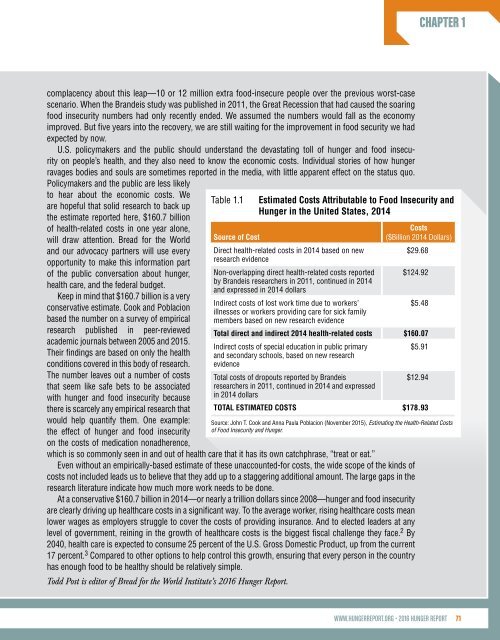THE NOURISHING EFFECT
HR2016-Full-Report-Web
HR2016-Full-Report-Web
Create successful ePaper yourself
Turn your PDF publications into a flip-book with our unique Google optimized e-Paper software.
CHAPTER 1<br />
complacency about this leap—10 or 12 million extra food-insecure people over the previous worst-case<br />
scenario. When the Brandeis study was published in 2011, the Great Recession that had caused the soaring<br />
food insecurity numbers had only recently ended. We assumed the numbers would fall as the economy<br />
improved. But five years into the recovery, we are still waiting for the improvement in food security we had<br />
expected by now.<br />
U.S. policymakers and the public should understand the devastating toll of hunger and food insecurity<br />
on people’s health, and they also need to know the economic costs. Individual stories of how hunger<br />
ravages bodies and souls are sometimes reported in the media, with little apparent effect on the status quo.<br />
Policymakers and the public are less likely<br />
to hear about the economic costs. We<br />
are hopeful that solid research to back up<br />
the estimate reported here, $160.7 billion<br />
of health-related costs in one year alone,<br />
will draw attention. Bread for the World<br />
and our advocacy partners will use every<br />
opportunity to make this information part<br />
of the public conversation about hunger,<br />
health care, and the federal budget.<br />
Keep in mind that $160.7 billion is a very<br />
conservative estimate. Cook and Poblacion<br />
based the number on a survey of empirical<br />
research published in peer-reviewed<br />
academic journals between 2005 and 2015.<br />
Their findings are based on only the health<br />
conditions covered in this body of research.<br />
The number leaves out a number of costs<br />
that seem like safe bets to be associated<br />
with hunger and food insecurity because<br />
there is scarcely any empirical research that<br />
would help quantify them. One example:<br />
the effect of hunger and food insecurity<br />
on the costs of medication nonadherence,<br />
Table 1.1<br />
Estimated Costs Attributable to Food Insecurity and<br />
Hunger in the United States, 2014<br />
Source of Cost<br />
Direct health-related costs in 2014 based on new<br />
research evidence<br />
Non-overlapping direct health-related costs reported<br />
by Brandeis researchers in 2011, continued in 2014<br />
and expressed in 2014 dollars<br />
Costs<br />
($Billion 2014 Dollars)<br />
$29.68<br />
$124.92<br />
Indirect costs of lost work time due to workers’<br />
$5.48<br />
illnesses or workers providing care for sick family<br />
members based on new research evidence<br />
Total direct and indirect 2014 health-related costs $160.07<br />
Indirect costs of special education in public primary<br />
and secondary schools, based on new research<br />
evidence<br />
$5.91<br />
Total costs of dropouts reported by Brandeis<br />
$12.94<br />
researchers in 2011, continued in 2014 and expressed<br />
in 2014 dollars<br />
TOTAL ESTIMATED COSTS $178.93<br />
Source: John T. Cook and Anna Paula Poblacion (November 2015), Estimating the Health-Related Costs<br />
of Food Insecurity and Hunger.<br />
which is so commonly seen in and out of health care that it has its own catchphrase, “treat or eat.”<br />
Even without an empirically-based estimate of these unaccounted-for costs, the wide scope of the kinds of<br />
costs not included leads us to believe that they add up to a staggering additional amount. The large gaps in the<br />
research literature indicate how much more work needs to be done.<br />
At a conservative $160.7 billion in 2014—or nearly a trillion dollars since 2008—hunger and food insecurity<br />
are clearly driving up healthcare costs in a significant way. To the average worker, rising healthcare costs mean<br />
lower wages as employers struggle to cover the costs of providing insurance. And to elected leaders at any<br />
level of government, reining in the growth of healthcare costs is the biggest fiscal challenge they face. 2 By<br />
2040, health care is expected to consume 25 percent of the U.S. Gross Domestic Product, up from the current<br />
17 percent. 3 Compared to other options to help control this growth, ensuring that every person in the country<br />
has enough food to be healthy should be relatively simple.<br />
Todd Post is editor of Bread for the World Institute’s 2016 Hunger Report.<br />
WWW.HUNGERREPORT.ORG • 2016 HUNGER REPORT 71


